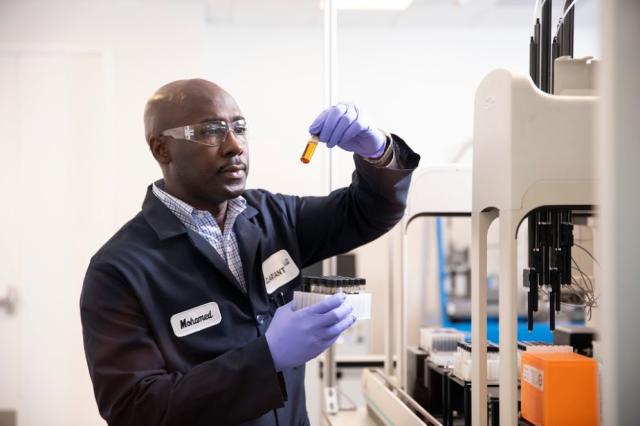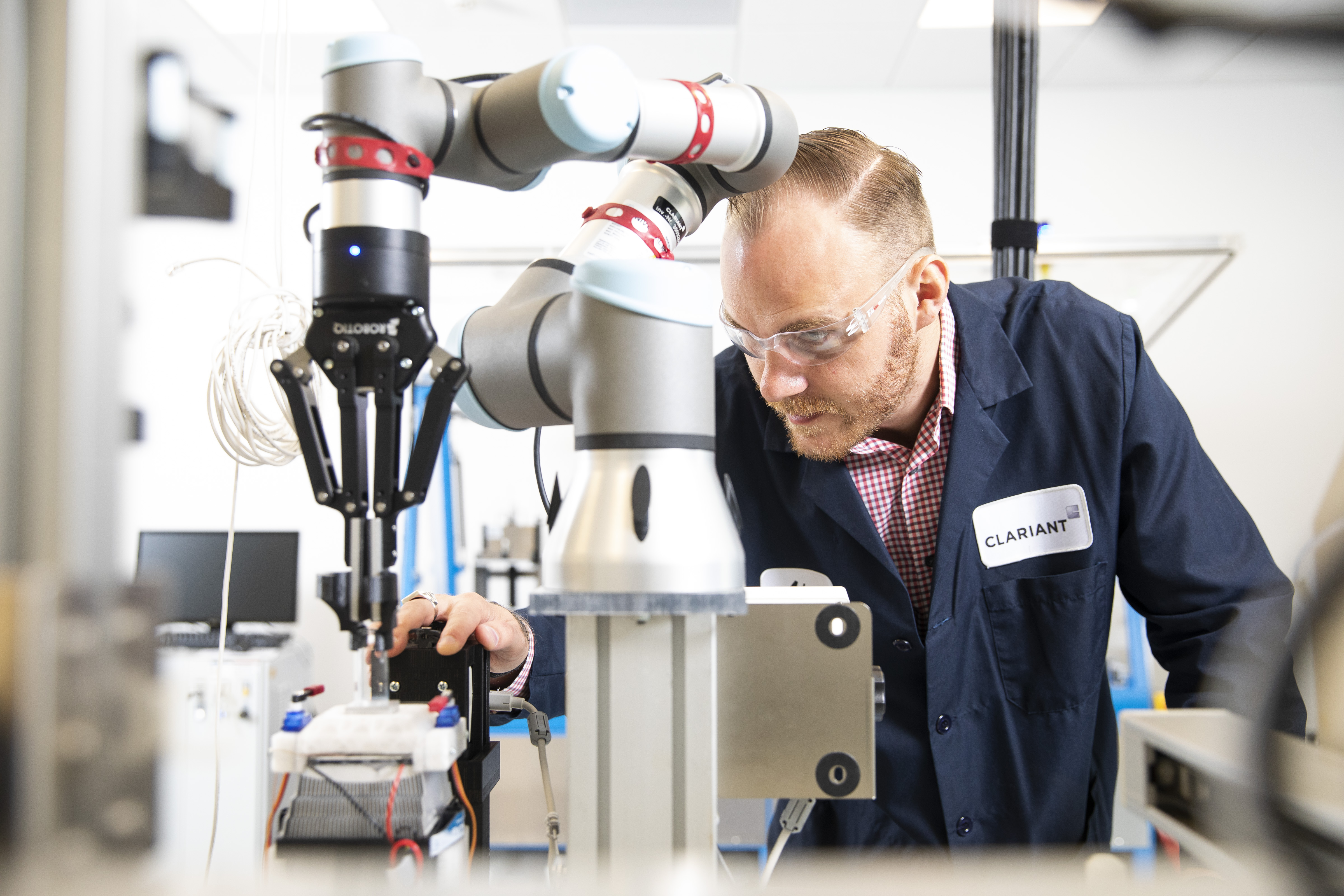
Using the HTE laboratory, Clariant chemists are able to identify new formulations and synergistic blends for specific customer crudes. (Source: Clariant)
Over the last several years, there has been an unprecedented increase in paraffin-related challenges in the world of production chemistry. As the production of easy-to-treat (e.g., light, sweet) crude oil declines, the industry is transitioning its focus to the more challenging crudes. What is unique about these newer crudes coming onstream is that they contain a complex mix of paraffinic components that in turn create a new suite of puzzling issues.
With the complexity of oil production in the ever-growing challenge of shale, and globally diverse crude oil grades, the fast development of oilfield production chemicals that support efficient production is both a differentiator and essential to meet the expectations of the oil operators in the industry.
To meet these demanding requirements, Clariant has introduced to the production chemical industry the use of high-throughput experimentation (HTE) methods for scientific experimentation alongside advanced analytics. Using this approach, Clariant can identify more precise chemical formulations that go through the application development far quicker than traditional manual laboratory methodologies. Originally developed for use in the pharmaceutical industry, the HTE method rapidly improves upon classical experimentation methodology. The contents of this article focus on the development of pour point depressant (PPD) technology that is used to prevent cold-temperature-driven crude oil gelation. Although there are several other application workflows already developed for other flow assurance areas such as hydrates, asphaltenes, corrosion and most recently scale, this article will focus on how the PPD technology helps to effectively maintain hydrocarbon flow.
Realizing efficient flow assurance
Where system conditions change through asphaltenes and paraffinic material in the oil, organic deposition problems can arise and negatively impact production efficiency. This can increase viscosity (and ultimately result in complete gelation of the crude) and affect flow and ultimate production deliverability.
There is a range of technologies designed to sustain efficient flow from such effects. One example is thermal insulation or even heating of flowlines. The drawback to this is the expense associated with the capital cost to construct heating stations and operating costs from the energy used.
Clariant has successfully used HTE to introduce another mechanism to keep the fluids flowing, which in turn improves total cost of operations for the customer.
PPD technology
PPDs do not change the temperature at which wax crystallizes or the amount of wax that builds up. Their application, in fact, relies on the PPD co-crystallizing with the targeted paraffin species present in the oil, thus modifying the wax crystal structures to one more favorable to allow flow. Furthermore, the wax crystals are kept isolated by the PPD backbone and, because of this steric hindrance, the wax crystals are no longer able to form 3 D structures that are responsible for gelation, therefore inhibiting flow.
The two areas where PPDs are most encountered are in upstream operational production where PPD treats the crude oil, allowing it to flow to the sales point while preventing wax deposition, and in midstream operations, where off-specification crude oil is treated before it arrives at a refinery (so called “opportunity crudes”) to be further purified.
Selecting the correct PPD
The first development step for a PPD is to measure the interaction it has with the viscosity of crude oil. The classic way to measure viscosity in a laboratory is with a technician operating a viscometer or rheometer. This method takes 30 to 40 minutes per measurement. In searching for solutions to speed up the development process, Clariant’s oilfield chemical experts turned to HTE. Over the last three years, Clariant has utilized its HTE laboratories to perform feasibility studies to prove that this new laboratory approach is useful in formulation development for the oil and gas industry.
At the heart of HTE is a mixture of robotics, data processing, control software, liquid handling devices and sensitivity detectors. Its development comes on the back of advances in smart automation, miniaturization, parallelization and statistical design. It decreases time to market, enabling faster discovery of new technologies, and delivers greater understanding of existing technology.
In the laboratory for PPD development, a series of robotic arms enables the movement of crude oil samples to miniaturized and parallel viscometers; it will work day and night, accelerating the testing process while also providing datapoints that otherwise would not be possible.
When HTE is combined with computational experimental design software it becomes even more effective. The Design of Experiment software mathematically analyzes the space in which fundamental properties are being measured. Instead of having to make 100 measurements to cover this space, it mathematically deconvolutes the data so that fewer measurements are required as it predicts the white space it leaves behind.

Although the software is commercially available, Clariant’s process of taking existing technologies and combining them in novel solutions is unique for the development of PPDs. It is now possible to explore multiple options for potential formulation using HTE by quickly disseminating formulations from one another. The result is a high degree of accuracy and speed enabling customized formulations to be developed for every single application that requires it.
Taking PPD innovation to the field
With the developing megatrend of heavier and harder-to-treat crude oil, easy-to-treat oil is a thing of the past. The HTE approach has been applied to some of the most challenging oil fields on the planet, ranging from East Africa to Canada and from Argentina to Malaysia. In East Africa, for example, the traditional way of treating crude oil, which can have the consistency of boot polish, is to heat it. For a 1,000-km pipeline, a heating station costing up to $2 million can be required every 50 km—a huge capital expense and operating cost. If an effective PPD chemistry could be provided to allow the crude to remain more liquid at a lower temperature, heating stations could be reduced to about one every 200 km. The savings from such an approach are considerable, and applying PPD solutions in East Africa is production-enabling for this region.
PPD formulation technology
Even with the most demanding crude oils, chemical formulation development through the HTE methodology can quickly provide solutions that help the customer’s oil to continue to flow. Clariant has developed a range of products within the four (generally accepted) existing classes of PPD molecules, which can be formulated in unique ways, to enable chemical synergies. Challenging crudes can be treated while improving production and lowering the total cost of operations.
Recommended Reading
President: Financial Debt for Mexico's Pemex Totaled $106.8B End of 2023
2024-02-21 - President Andres Manuel Lopez Obrador revealed the debt data in a chart from a presentation on Pemex at a government press conference.
From Restructuring to Reinvention, Weatherford Upbeat on Upcycle
2024-02-11 - Weatherford CEO Girish Saligram charts course for growth as the company looks to enter the third year of what appears to be a long upcycle.
TechnipFMC Eyes $30B in Subsea Orders by 2025
2024-02-23 - TechnipFMC is capitalizing on an industry shift in spending to offshore projects from land projects.
NOV's AI, Edge Offerings Find Traction—Despite Crowded Field
2024-02-02 - NOV’s CEO Clay Williams is bullish on the company’s digital future, highlighting value-driven adoption of tech by customers.
Patterson-UTI Braces for Activity ‘Pause’ After E&P Consolidations
2024-02-19 - Patterson-UTI saw net income rebound from 2022 and CEO Andy Hendricks says the company is well positioned following a wave of E&P consolidations that may slow activity.




